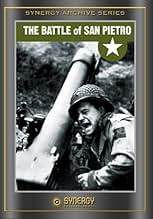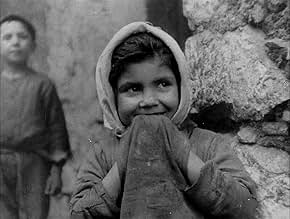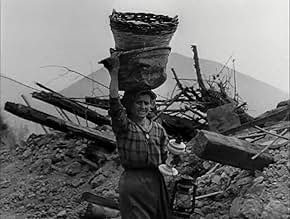VALUTAZIONE IMDb
6,6/10
2590
LA TUA VALUTAZIONE
Aggiungi una trama nella tua linguaDirector John Huston documents the Battle of San Pietro Infine in December 1943.Director John Huston documents the Battle of San Pietro Infine in December 1943.Director John Huston documents the Battle of San Pietro Infine in December 1943.
- Regia
- Sceneggiatura
- Star
- Premi
- 1 vittoria in totale
Mark W. Clark
- Self - Introduction
- (non citato nei titoli originali)
John Huston
- Narrator
- (voce)
- (non citato nei titoli originali)
Recensioni in evidenza
I don't know how this documentary ever managed to be released in 1945 while the war was still underway. Other examples of the genre always ended in victory. Allied dead were never seen except at funeral services with flags flying and officers making speeches and a solemn narrator telling us of their brave deeds.
Huston's documentary is different. The narration is by the director and is full of the logic of battle and lacks sentiment. The film is shot from ground level, the level of the foot soldier. A phosphorous shell explodes some feet away, the ground trembles, and the air is filled with bits of burning chemicals. An American soldier is shot in mid-stride and flops unceremoniously to the ground. There are multiple shots of American dead, some being bundled into mattress covers and lowered into hasty graves by the Quartermaster Corps.
Only one speech is delivered, by General Mark Clark at the opening of the film. He was in charge of American forces in Italy and always saw to it that the press referred to the Fifth Army as "General Mark Clark's Fifth Army." Clark points out that there was great sacrifice during the campaign and hints that it might not have been so great if the Army hadn't seen fit to rob him of resources for the invasion of France. Nevertheless, he observes, we kept many Germans pinned down in Italy. No mention of the fact that the Allies too were bottled up in Italy with the Germans acting as the cork.
Huston uses a simple map and pointer to illustrate the tactical situation. And his narration is blunt. The attack on the German's right was launched and not a man got more than 300 yards beyond his starting point. All our attacks were repeatedly repulsed with heavy losses. And when at last the Germans withdrew, they did so swiftly and according to plan, and took up new defensive position five kilometers away.
Five kilometers away. That meant a new battle against a new defensive line. And after that, another battle against another defensive line, with all the German artillery sighted in, and their positions camouflaged and mutually supporting.
There was nothing else to be done. The Italian boot seemed made for defense, with a high mountain range forming a spine down the center, and innumerable smaller ranges to the east and west, interspersed with rivers that swelled during the winter rains. The obstacles and mud often halted operations entirely.
I suppose that's one of the reasons why we don't see very much footage of combat from the Italian campaign on television. It wasn't colorful. It wasn't glamorous. It didn't end in a smashing victory. The Battle of San Pietro was an early one, and Monte Casino and the Gustav Line and other terrors still lay ahead.
The closest Hollywood ever came to capturing the misery associated with the Italian campaign was in William Wellman's "The Story of G.I. Joe" -- and even there, the despair these men must have felt is muted by the homespun voice over of Burgess Meredith as Ernie Pyle. Huston evidently staged many of the combat scenes but I still don't know how Huston's short film managed to get past the wartime censors.
Huston's documentary is different. The narration is by the director and is full of the logic of battle and lacks sentiment. The film is shot from ground level, the level of the foot soldier. A phosphorous shell explodes some feet away, the ground trembles, and the air is filled with bits of burning chemicals. An American soldier is shot in mid-stride and flops unceremoniously to the ground. There are multiple shots of American dead, some being bundled into mattress covers and lowered into hasty graves by the Quartermaster Corps.
Only one speech is delivered, by General Mark Clark at the opening of the film. He was in charge of American forces in Italy and always saw to it that the press referred to the Fifth Army as "General Mark Clark's Fifth Army." Clark points out that there was great sacrifice during the campaign and hints that it might not have been so great if the Army hadn't seen fit to rob him of resources for the invasion of France. Nevertheless, he observes, we kept many Germans pinned down in Italy. No mention of the fact that the Allies too were bottled up in Italy with the Germans acting as the cork.
Huston uses a simple map and pointer to illustrate the tactical situation. And his narration is blunt. The attack on the German's right was launched and not a man got more than 300 yards beyond his starting point. All our attacks were repeatedly repulsed with heavy losses. And when at last the Germans withdrew, they did so swiftly and according to plan, and took up new defensive position five kilometers away.
Five kilometers away. That meant a new battle against a new defensive line. And after that, another battle against another defensive line, with all the German artillery sighted in, and their positions camouflaged and mutually supporting.
There was nothing else to be done. The Italian boot seemed made for defense, with a high mountain range forming a spine down the center, and innumerable smaller ranges to the east and west, interspersed with rivers that swelled during the winter rains. The obstacles and mud often halted operations entirely.
I suppose that's one of the reasons why we don't see very much footage of combat from the Italian campaign on television. It wasn't colorful. It wasn't glamorous. It didn't end in a smashing victory. The Battle of San Pietro was an early one, and Monte Casino and the Gustav Line and other terrors still lay ahead.
The closest Hollywood ever came to capturing the misery associated with the Italian campaign was in William Wellman's "The Story of G.I. Joe" -- and even there, the despair these men must have felt is muted by the homespun voice over of Burgess Meredith as Ernie Pyle. Huston evidently staged many of the combat scenes but I still don't know how Huston's short film managed to get past the wartime censors.
10marie_D
This film is available on DVD -- as part of the "Treasures from American Film Archives" collection released this year. The collection has lots of gems on its four disks but "The Battle of San Pietro" alone would make it worth the price.
I watched this 30-minute documentary of one of many battles in Italy shortly after having viewed "All Quiet on the Western Front" for the first time. I thought the Milestone film was brilliant but it was this Huston documentary that made me cry. I don't know whether it is the matter-of-fact narration (by the director), the sight of all those G.I.s, or the Italian children that got to me but the sum of it all was almost overwhelming. Very highly recommended. 10/10
I watched this 30-minute documentary of one of many battles in Italy shortly after having viewed "All Quiet on the Western Front" for the first time. I thought the Milestone film was brilliant but it was this Huston documentary that made me cry. I don't know whether it is the matter-of-fact narration (by the director), the sight of all those G.I.s, or the Italian children that got to me but the sum of it all was almost overwhelming. Very highly recommended. 10/10
i recently saw the approx. 40min version of this film and i must say, knowing what is missing from the 32min version, that it is indeed far more impactful and superior. images of more fallen soldiers in white body bags appear and reappear throughout to the point of it being a reocurring theme. i'm sure it's just as brilliant without the extra footage, but if you can, try to see the extra footage. while i have not seen the true original (running approx. 50min), i'm quite positive it's even better than the one i was fortunate enough to see. a great documentary film all-around (even if some of it was staged).
I was expecting quite a bit from this movie, as it's often being credited as being an intriguing WW II (anti)war documentary, that puts you right in the middle of things. It does feature some unique and straight-forward battle images but to me it just didn't all worked out.
To me this movie looks and feels more like a news reel than an actual documentary about the accounts of the battle of San Pietro. This might sound like a compliment but it isn't really. The movie tells a story and it features lots of footage but it all feels glued together. To me it's even doubtful if the narration and images even belong together. The entire narration tells how the battle progressed but I doubted that all of the footage got shot during any of those talked about events. My suspicion got confirmed by the end of the movie, when a disclaimer got shown saying some of the footage got shot before and after the battle but were put into the movie for continuity reasons.
The narration by John Huston keeps the movie going at all times but it makes things happen a bit too fast as well really. Guess this is not the creator's fault but more the war department's that heavily cut the movie down because the movie got considered to be too anti-war by them.
The movie is mostly considered to be anti-war because it's being pretty straight-forward and of course honest. You'll see death bodies in this movie and allies taking some heavy blows by the Nazi-enemy. This of course however this present day only works out as realistic and more interesting as well.
After watching this movie I still don't feel like I knew what happened all during the battle of San Pietro, or why this battle was considered to be such a distinctive or important one to the allied campaign. But this again is also mostly due to the movie its too high pace.
WW II-buffs will still 'enjoy' this movie for what it is, due to its unique footage but don't expect to learn much or to be blown away by any of the movie its images.
6/10
http://bobafett1138.blogspot.com/
To me this movie looks and feels more like a news reel than an actual documentary about the accounts of the battle of San Pietro. This might sound like a compliment but it isn't really. The movie tells a story and it features lots of footage but it all feels glued together. To me it's even doubtful if the narration and images even belong together. The entire narration tells how the battle progressed but I doubted that all of the footage got shot during any of those talked about events. My suspicion got confirmed by the end of the movie, when a disclaimer got shown saying some of the footage got shot before and after the battle but were put into the movie for continuity reasons.
The narration by John Huston keeps the movie going at all times but it makes things happen a bit too fast as well really. Guess this is not the creator's fault but more the war department's that heavily cut the movie down because the movie got considered to be too anti-war by them.
The movie is mostly considered to be anti-war because it's being pretty straight-forward and of course honest. You'll see death bodies in this movie and allies taking some heavy blows by the Nazi-enemy. This of course however this present day only works out as realistic and more interesting as well.
After watching this movie I still don't feel like I knew what happened all during the battle of San Pietro, or why this battle was considered to be such a distinctive or important one to the allied campaign. But this again is also mostly due to the movie its too high pace.
WW II-buffs will still 'enjoy' this movie for what it is, due to its unique footage but don't expect to learn much or to be blown away by any of the movie its images.
6/10
http://bobafett1138.blogspot.com/
These comments helped me a lot' It is impressive in describing both the events and the atmosphere of a desperate and costly struggle, and it is memorable in preserving its effect on those who had to live through it.
This documentary movie is about the battle of San Pietro, a small village in Italy. Over 1,100 US soldiers were killed while trying to take this location, that blocked the way for the Allied forces from the Germans'
Well i do watched film not the whole of it but i cant get the documentary devices the filmmaker used, uniqueness in the film e.g in Triumph of the Will everyman has got Hitler' s hairstyle and how the editing together with shots relate to what the film is about. Also why is that women and children are shown smiling? Which type of shots are mostly used? What causes this battle? Who won the Battle and what are the effects brought by this fighting apart from people dying? What is the filmmaker trying to explain to the world?Please anyone explain to me.I will be happy... Really want to know about this film Thanks a lot
This documentary movie is about the battle of San Pietro, a small village in Italy. Over 1,100 US soldiers were killed while trying to take this location, that blocked the way for the Allied forces from the Germans'
Well i do watched film not the whole of it but i cant get the documentary devices the filmmaker used, uniqueness in the film e.g in Triumph of the Will everyman has got Hitler' s hairstyle and how the editing together with shots relate to what the film is about. Also why is that women and children are shown smiling? Which type of shots are mostly used? What causes this battle? Who won the Battle and what are the effects brought by this fighting apart from people dying? What is the filmmaker trying to explain to the world?Please anyone explain to me.I will be happy... Really want to know about this film Thanks a lot
Lo sapevi?
- QuizThis film was considered so blunt in its depiction of the difficulties of the battle that the US Army refused to show it, believing it to be damaging to troop morale.
- ConnessioniEdited into I forzati della gloria (1945)
I più visti
Accedi per valutare e creare un elenco di titoli salvati per ottenere consigli personalizzati
Dettagli
- Tempo di esecuzione32 minuti
- Colore
- Mix di suoni
- Proporzioni
- 1.37 : 1
Contribuisci a questa pagina
Suggerisci una modifica o aggiungi i contenuti mancanti

Divario superiore
By what name was San Pietro (1945) officially released in India in English?
Rispondi





















